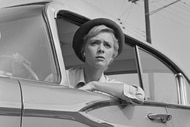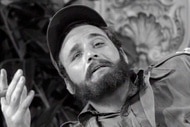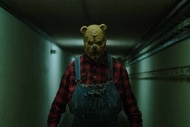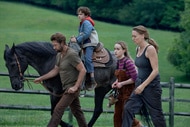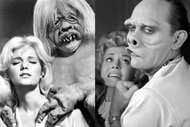Create a free profile to get unlimited access to exclusive videos, sweepstakes, and more!
How the Real-Life Trial of a Nazi War Criminal Inspired This Classic Episode of The Twilight Zone
Serling, who wasn't able to fight the Nazis during World War II, got a revenge of sorts with this episode.

This feels weird to say, but the original iteration of The Twilight Zone (airing regularly on SYFY) was kind of like The South Park of its day. The groundbreaking, multi-genre anthology created by Rod Serling constantly had its finger on the cultural pulse, unafraid to shine a spotlight on frightening and controversial topics like nuclear proliferation, institutionalized bigotry, and the depravity lurking inside us all.
One such episode that captured the biggest headlines of the day was Season 3's "Deaths-Head Revisited," in which a remorseless Nazi war criminal (Oscar Beregi) who escaped to South America after World War II tries to relive the "glory days" by returning to the ruins of the Dachau concentration camp in Germany. The man's sadistic nostalgia is short-lived when he is ultimately put on trial by the spirits of the people he tortured and murdered there. Joseph Schildkraut particularly stands out as the spectral, sunken-eyed "caretaker" of the camp, Alfred Becker.
For More on The Twilight Zone:
The One Word That Only Rod Serling Could Write in Twilight Zone Scripts
How the Twilight Zone Created A Nuclear Apocalypse for "Time Enough at Last"
Submitted For Your Approval: Rod Serling's Daughters Reveal Their Favorite Episodes of The Twilight Zone
How The Trial of a Nazi War Criminal Influenced The Twilight Zone
As Gordon F. Sander points out in Serling: The Rise and Twilight of TV's Last Angry Man, the haunting (both literally and figuratively) exploration of the Third Reich's genocidal machinations and the importance of remembering the Holocaust, "Deaths-Head Revisited" was written by Serling as a reaction to the high-profile trial of Adolf Eichmann, which was nearing its end by the time the episode (named after the SS guards who presided over concentration camps) aired in November 1961.
A key figure in carrying out Hitler's "Final Solution," Eichmann fled to Argentina after the war, assuming the identity of Ricardo Klement and taking up residence at 14 Garibaldi Street. He was eventually tracked down and captured by Mossad agents in a daring — and highly dangerous — mission that has since been dramatized many times (the most recent example being director Chris Weitz's Operation Finale).
The elusive war criminal stood trial in Israel and was executed for crimes against humanity in 1962. His seemingly normal appearance and demeanor prompted journalist Hannah Arendt to coin the famous phrase "the banality of evil."
The legal proceedings, which gained news coverage from all around the world, must have had a profound impact on Serling, who was Jewish and signed up for the military during WWII with the express intention of going to Europe to fight the Nazis and their virulent brand of anti-Semitism. In a Twilight Zone-esque twist of fate, however, Serling ended up in the Pacific, though he got a revenge of sorts with this episode. "He was extremely proud of his heritage," Rod's daughter, Anne Serling, told SYFY WIRE in 2020. "These are things that my dad was passionate about, felt needed to be told over and over again and remembered. They still need to be remembered and talked about."
Serling would go on to punish another Nazi in the debut episode of his NBC anthology series, Night Gallery, whose debut episode featured a segment about a German war criminal (Richard Kiley) cursed to a state of eternal suffering after he's trapped inside a painting. Interestingly, the portrait in question (painted by Universal artist Jaroslav Gebr) is now owned by Oscar-winning filmmaker, Guillermo del Toro.
Missed SYFY's Fourth of July Twilight Zone marathon? No problem at all! Episodes of the classic anthology air regularly on the network. Click here for more scheduling information.



